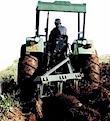|
This economic sector created rural employment and income by utilising natural resources on which local processing industries could be based.
Maize production more than doubled from the time of independence until 1981 when 138 000 tonnes of maize was produced.
Other agricultural schemes included intensive dairy and poultry farming, and cattle grazing zones.
Although farming, as with other economic activities, was seen as the preserve of private enterprise, the Department of Agriculture took steps to promote an environment for participation by rural communities.
Among the bodies which were created to promote agriculture was the Agricultural Development Corporation (Agricor).
The Agricultural Bank of Bophuthatswana’s growth in the first five years of its existence was phenomenal and highlighted the bank’s service to the agricultural sector on which on estimated 80% of the country’s population was to some extent dependent.
Agricultural development programmes also included community upliftment that linked all aspects of village life in a concerted drive for economic and social advancement based on the income derived from improved farming practices.
Agricultural education was further promoted by the Department at the Taung Agricultural College where agricultural officers were trained to teach farmers modern techniques.
The Department provided other services including a veterinary programme to inspect dipping procedures, pest and disease control and assistance to co-operative bull breeding schemes which improved the general standard of stock throughout the country.
Government’s concern for its people was best expressed by the measures it took in May 1983 to alleviate the country’s severe drought when the Executive Council appointed a Cabinet Committee to deal with the situation.
During the first 30 months of the operation drought relief:
- Fed on a regular basis 42 000 destitute men, women and children in rural areas;
- Established hundreds of food gardens;
- Provided 32 000 tonnes of cattle feed to farmers whose animals were in danger of perishing;
- Removed over 45 000 unproductive cattle from the veld;
- Transported nearly 26 million litres of water to villages, schools, clinics and other institutions where water supplies had failed;
- Sunk and equipped 81 new boreholes in villages where supplies had failed;
- Repaired over 480 boreholes where machinery had failed; and
- Provided wages for 2 500 farm labourers.
The Department of Agriculture further provided fieldworkers who offered an advisory service to farmers including animal and crop production, animal health and forestry.
Other major agricultural development projects included:
- The Eerstepoort dam;
- Shiela dryland project;
- The Taung irrigation schemes; and
- The Mimosa nest poultry project.
State veterinarians were located at strategic points from where they could offer specialised service in animal health to farmers, and a farmer training centre offered courses in crop and animal production, machinery maintenance, animal health, vegetable production, poultry keeping and irrigated crop production. |

|
|

